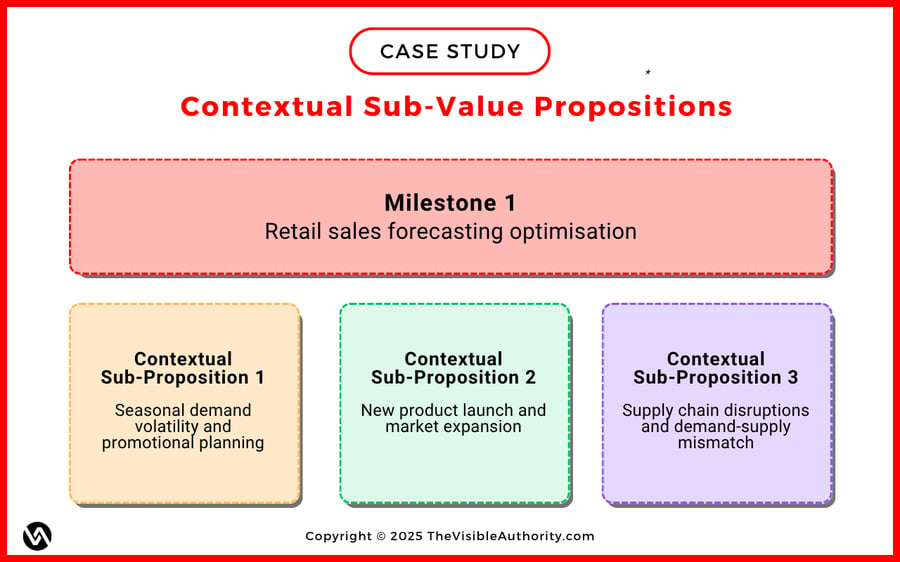
[Case Study] Moving From a Generic to a Specific Consulting Value Proposition

Data & Analytics Consulting Firm
Executive Summary
A generic data and analytics consulting firm transitioned from offering generic services to specialising in improving supermarket operations over a two-year period. They followed our four-sprint approach, focusing on strategic alignment, value proposition design (starting with sales forecasting), client success journey design, and commercial enablement.
This phased approach involved testing and validating a new value proposition before a complete rebrand. The firm successfully increased deal size, established long-term contracts, reduced client acquisition costs, and achieved scalable, journey-based growth by specialising and focusing on specific contextual client needs.
Chapter 1: Client Background and Context
The firm began as a typical Q1 data and analytics consultancy, offering generic services such as data integration, data cleaning, data visualisation, business intelligence solutions, etc., to various industries and client profiles.

However, four years after founding, they recognised that their undifferentiated Q1 position and value proposition risked further commoditisation and intense price competition. This was driven by the fierce battle against the Big 4 and brutal competition from contractors, freelancers, and other similar boutique consulting firms.
They aspired to develop a narrower and more specific focus to differentiate themselves and capture premium pricing, solving high-stake business issues in a much more targeted market.
At the start of the project, the decision to specialise in a specific client segment had not yet been made. The consultancy had the strong ambition to evolve into a Q4 player, a consulting firm known for its specialised expertise in a clearly defined market. Still, it had not yet determined the precise market or client focus.
That's where we came in. The consulting firm asked for our support to help identify the most promising specialisation path, assess their existing strengths, design a differentiating consulting value proposition, co-create a client success journey that would define their differentiation in the market, map their services on the client journey, and help them set up their future business development approach – all without risking the immediate erosion of the existing data & analytics revenue/clients.
We call this ‘the fade-in the new and fade-out the old approach’. Ultimately, they sought to eliminate the generic data and analytics profile step by step. After completing our project work in the first three months, they aimed to complete the entire consulting firm transformation and build the entire client success journey within approximately two years.
Recommended reading: The Consulting Value Proposition Quadrant
Chapter 2: Our Approach – The 4 Sprints
Our approach consisted of four tightly connected sprints during 12 weeks, each building toward a sharper, outcome-led proposition, a scalable service architecture, and a more effective commercial engine. Here’s what we did:
Sprint 1: Strategic Alignment & Commercial Foundations
In this first phase, we aligned the firm’s leadership around a new growth strategy, identified the most impactful past engagements (our ‘Best Engagements Review’), and set the direction for their future market positioning. This was crucial for understanding what had already worked and where their future specialisation could create the most significant impact.
The best engagement review promptly highlighted potential directions for their future proposition, aligning with their ambitions. Much of their best work occurred in Q3 (retail industry focus) and Q2 (sales forecasting specialisation), with the highest previous revenue coming from the supermarket sector (Q3 quadrant).
Sprint 2: Value Proposition Design
Reviewing and discussing options in this sprint, the team narrowed the proposition down to helping retail companies improve operations. We co-created a clear, differentiated consulting value proposition anchored in real client issues that would form the backbone of their Q4 journey.
This included defining the key business issues to solve, for whom, and why they matter, ensuring their message would resonate in a competitive market. They decided to first focus on building the Sales Forecasting Improvement for Supermarkets proposition, testing and validating it, and then start building additional services within a client success journey concept, as created in the next sprint.
Sprint 3: Client Success Journey Design
Once the initial value proposition (Sales Forecasting) was defined, we connected it to a practical client success journey. We mapped the stages in which clients could realise value, from initial conversations to profound, long-term transformation.
This included mapping their service offerings onto the client journey, ensuring each stage had clear, outcome-focused services aligned with their target market's specific needs and pain points. This journey design helped to identify trust-building entry points, natural expansion paths, and the critical role of service design in delivering on their promise.
Recommended reading: Why Consulting Value Propositions Must Include a Client Success Journey
Sprint 4: Commercial Enablement
Finally, we equipped the team with the tools, structure, and initial key actions needed to test, validate, and sell their new proposition confidently. This included developing a go-to-market strategy to support long-term commercial success, business development playbooks and templates for core collateral (such as the website, social media, and pitch deck), and a small yet practical program that the firm could run to validate its initial value proposition (Sales Forecasting) while creating market visibility.
Chapter 3: Our Role – Co-Creating the New Consulting Value Proposition in 2 Phases
In collaboration with our team, the consultancy undertook a comprehensive repositioning project that included:
- Intensive business deep dive and client segmentation analysis based on their past ‘best client engagements’ and future ambitions
- Co-creation of a new consulting value proposition in 2 phases:
- Phase 1: focus on sales forecasting improvements for supermarkets, targeting three core business issues/challenges (see the visual below)
- Phase 2: building the client success journey beyond sales forecasting (see visual #2)
- (Phase 3: (not yet started) targeting adjacent industries, such as fashion retail & e-commerce)

Chapter 4: Milestone-Based Success Journey

Expanding upon the firm’s newly-focused proposition (starting with Sales Forecasting Improvements), we co-created a journey featuring three core milestones:
Milestone 1: Discovery and Direction Setting
- Services: Data Feasibility Study, Data Quality Assessment, Data Integration & Cleaning Program, and Readiness Assessment & Transformation Roadmap
- Focus: Establishing a clear strategic direction grounded in current data capabilities and business objectives.
- Outcome: Aligned stakeholders, realistic expectations, and a practical roadmap to guide the transformation journey.
Milestone 2: Foundational Forecasting and Inventory Optimisation
- Services: Sales Forecasting (the initial proposition), Store Inventory Management
- Focus: Building a strong data foundation for precise demand planning and inventory management.
- Outcome: Reduced stockouts, lower carrying costs, and fewer markdowns.
Milestone 3: Customer-Centric Strategy Development
- Services: Shopper Segmentation, Pricing Optimisation
- Focus: Developing customer-centric strategies to improve customer experience and profitability.
- Outcome: Higher customer retention, better pricing margins, and more personalised marketing.
Milestone 4: Store Performance and Risk Control
- Services: Store Layout Optimisation, Fraud and Theft Detection Analytics
- Focus: Using integrated data to optimise physical store performance and reduce operational risks.
- Outcome: Lower loss rates, improved sales per square foot, better customer experience.
Defining this client success journey had two goals:
- Designing the client-facing services
- Developing the firm’s internal capabilities. This included building the expertise, use cases, and operational capacity to deliver on the three milestones. In practice, this meant that as they defined each stage of the client journey, they were simultaneously developing their internal capacity to support these stages, from data modelling for sales forecasting to more complex analytics, e.g. pricing and risk management.
Importantly, this development journey was carefully phased. They started immediately with the services linked to Milestones 1 and 2, as their Best Engagement Review confirmed they already had a solid foundation and expertise in these expertise domains. This allowed them to quickly gain momentum and confidence while building the more advanced capabilities required for the later stages of the journey.
Chapter 5: The Go-to-market
We cannot disclose all the details of their GTM, but the most important takeaway of the project is the phased GTM approach (see also Chapter 3):
- Phase 1: The GTM for the new consulting value proposition ‘Sales Forecasting Improvements for Supermarkets’ was executed ‘at the campaign level’. This means that the core identity of the consulting firm remained 90% unchanged. Still, the homepage got a reference to the new Sales Forecasting value proposition (leading to a dedicated campaign landing page). The idea was twofold: 1) testing & validating the new value proposition, and 2) careful management of the existing (generic analytics) clients.
- Phase 2: The consulting firm's new identity was launched, with a full-blown GTM, launch campaign, client event, new homepage, etc. Existing (generic analytics) clients were informed step by step of the new focus and the future fade-out of generic analytical services.
Chapter 6: Results and Impact
Over nearly two years, the consultancy transitioned from a generic data and analytics provider to a highly specialised firm with a sharp, differentiating value proposition built around a structured client success journey. The laser-sharp focus on supermarkets allowed them to achieve four key results:
- Significantly increase their average deal size.
- Create multi-year contracts and long-term client relationships (including a managed service agreement).
- Reduce client acquisition costs by focusing on journey-based upselling and deeper client relationships.
- Move from headcount-dependent growth as a generic data & analytics firm to journey-based scalability.
Chapter 7: Lessons Learned
The consultancy’s journey highlights the value of intentional proposition design and narrow focus over opportunistic growth. It demonstrates the power of deeply understanding a specific client segment, building a differentiating value proposition, and a structured client success journey.
Aligning services to each of the four strategic milestones provided a clear path for delivering measurable client value. This shift has already increased profitability and created a more resilient business model with recurring revenue streams.
As we always say, they transformed the consulting firm from a “We do X” (generic data and analytics) positioning to “We solve X” (improving supermarket operational performance).
Interested in receiving all our learnings to build a better consulting firm?
Subscribe to our newsletter.

Luk Smeyers & Florian Heinrichs
Luk’s extensive career in the consulting business, which spans more than 20 years, has seen him undertake a variety of influential positions. He served as the European CHRO for Nielsen Consulting (5,000 consultants in the EU), founded iNostix in 2008—a mid-sized analytics consultancy—and led the charge in tripling revenue post-acquisition of iNostix by Deloitte (in 2016) as a leader within the Deloitte analytics practice. After fulfilling a three-year earn-out period at Deloitte, Luk harnessed his vast experience in consultancy performance improvement and founded TVA in 2019. ♦️ Florian brings over ten years of experience in consultancy business development and marketing across international agencies and in-house roles at Deloitte and Accenture. As a senior consultant at TVA since 2022, Florian focuses on refining business development strategies, enhancing value propositions, and optimising client journeys to drive business development ROI. His pragmatic approach ensures that essential elements are in place for firm growth and performance improvement.

